I absolutely love making my own fruit and veggie powders at home and dried carrot powder is no exception.
I think its the versatility that makes me so giddy about it.
And especially with homemade carrot powder, you can put it in just about everything to instantly boost the recipe’s nutritional profile.
I add carrot flour (which is another name for it in powdered form) to almost all my soups, stews, chili, and casseroles. It doesn’t change the taste much, and it’s a super sneaky smart way to get more vegetables in my kids!
First, let me give you the recipe, then we’ll talk about how to use it and address some frequently asked questions.
Print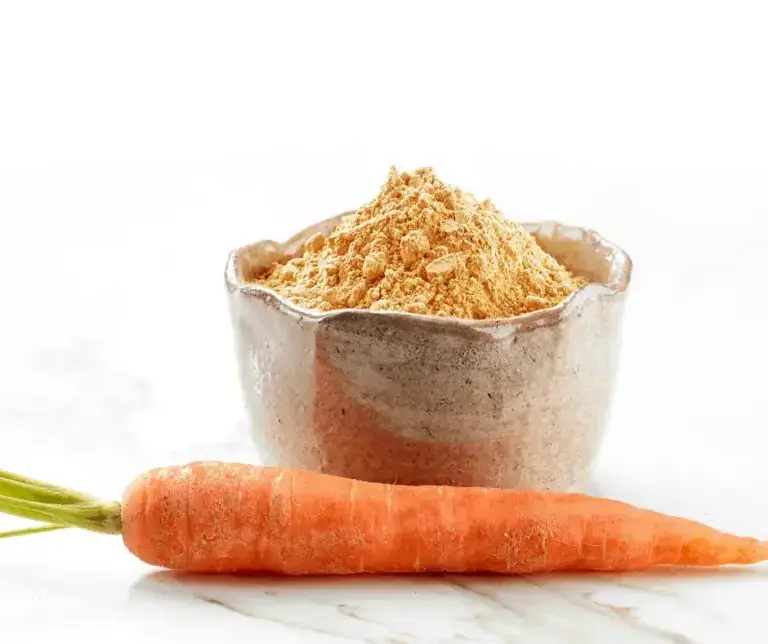
Super Simple Carrot Powder Recipe
You’ll love how versatile carrot powder can be. Use it like a regular food seasoning to add interesting flavors to your dish or simply boost its nutrition value. Follow this simple, super easy recipe to make carrot powder at home.
- Total Time: 6 hours 5 minutes
Ingredients
- Carrots
Instructions
- Prep the carrots by removing the leaves, tops and ends. Wash thoroughly and scrub off as much dirt as possible. Then, peel off the skins.
- Slice the carrots into around 1/8 thick pieces.
- Optional: Blanch carrots for 2 minutes, then transfer to an ice bath for 3 minutes.
- Dehydrate for 6-10 hours at 125 degrees Fahrenheit in a dehydrator or oven.
- Once dried completely, let the dehydrated carrots cool in room temperature.
- Run the pieces through a food processor or high-speed blender to grind them into a fine powder.
- Store in an airtight jar away from direct light and heat.
- Prep Time: 5 minutes
- Additional Time: 0 hours
- Cook Time: 6 hours
How to Make Carrot Powder Without a Dehydrator
If you don’t have a dehydrator, you can just use your oven to dry carrots as an alternative. After prepping, slice the carrots into circles, around less than a centimeter thick. Next, blanch these for two minutes.
Once done, soak the blanched carrots in a bowl of cold water with ice cubes to avoid overcooking.
Now time to put these into the oven for drying. To start, place a rack that’s covered with a cheesecloth inside a baking dish. Put the carrots on the rack with ample space in between the pieces for good air circulation.
Set the oven to around 125 degrees Fahrenheit to 135 degrees Fahrenheit. If that’s not possible, adjust it to the lowest temperature setting, perhaps, around 150 degrees Fahrenheit, then just prop the oven door open.
The drying process should take somewhere between six to eight hours. Once completely dried, take the carrots out of the oven. Let them cool in room temperature. Now, you’re ready to turn those dried carrots into powder.
Just run them through a food processor, and voila! You now have carrot powder fresh out of the food processor. Store it in an airtight glass jar away from high temperatures.
If you have some carrots that are about to go bad, read my guide for storing carrots properly.
How to Use Carrot Powder
This humble ingredient has found its way both in the culinary and beauty care world. In cosmetics, it is used as a natural colorant in soaps, scrubs and other beauty care products.
It’s included in the ingredients of some high-quality lotions, creams, ointments, massage oils, facial toners, facial masks, as well as shampoos and conditioners. For self-care weekends, you can add it in your bath bomb recipes for an instant spa-like rejuvenation at home.
Because of its high concentration of vitamins, specifically, beta-carotenes, it also aids in the treatment of various health issues such as anemia, allergies, rheumatic conditions, constipation and diarrhea. It’s also primarily beneficial for vision improvement.
Since its packed with nutrients that bring about tons of benefits for one’s health, you can regularly use carrot powder at home by adding it to soups, dips, and baked delights such as breads, cakes, cupcakes, macarons, cookies, and just about anything!
For happy, energetic and nutrient-filled mornings, add a tablespoon of carrot powder to your smoothie or include it in a pancake recipe.
Skin Benefits of Carrot Powder & How to Use It
As mentioned, carrot powder has a wide range of uses in cosmetics, and the secret lies in its skin-friendly nutrients and antioxidants including beta carotene, lycopene and lutein. These carotenoids help in keeping your skin maintain its healthy glow and complexion.
They also play a vital role in wound healing. Aside from helping your skin heal faster, these carotenoids also aid in preventing inflammation and infections. They may potentially help reduce the appearance of signs of aging too.
A lot of us are firm believers of the principle, “You are what you eat.” Our skin will reveal that healthy, young-looking, blemish-free glow if we are conscious about our diet.
That said, try to include carrot powder in the healthy foods you’re already eating. For example, you can add it in your oatmeal, smoothies, juices and soups, among many others.
You can also add it in your body scrub recipe, or make an all-natural facial mask using this as one of the ingredients. All-natural, vegan soaps and other skincare products infused with this skin-healthy ingredient are also available in the market. You can always try which works for you best.
Is Carrot Powder & Carrot Flour the Same Thing?
Pretty much yes, but carrot powder is usually made of whole dehydrated carrots while carrot flour is sometimes made out of just the carrot peels.
Carrot flour can be used as a substitute for up to ¼ cup of your wheat flour in your breads and pastries. On the other hand, you can add carrot powder to any dish, drink, or even homemade skincare products.
Well that about does it for today. Just trust me on this, once you know how to make carrot powder, you’ll add it to everything!

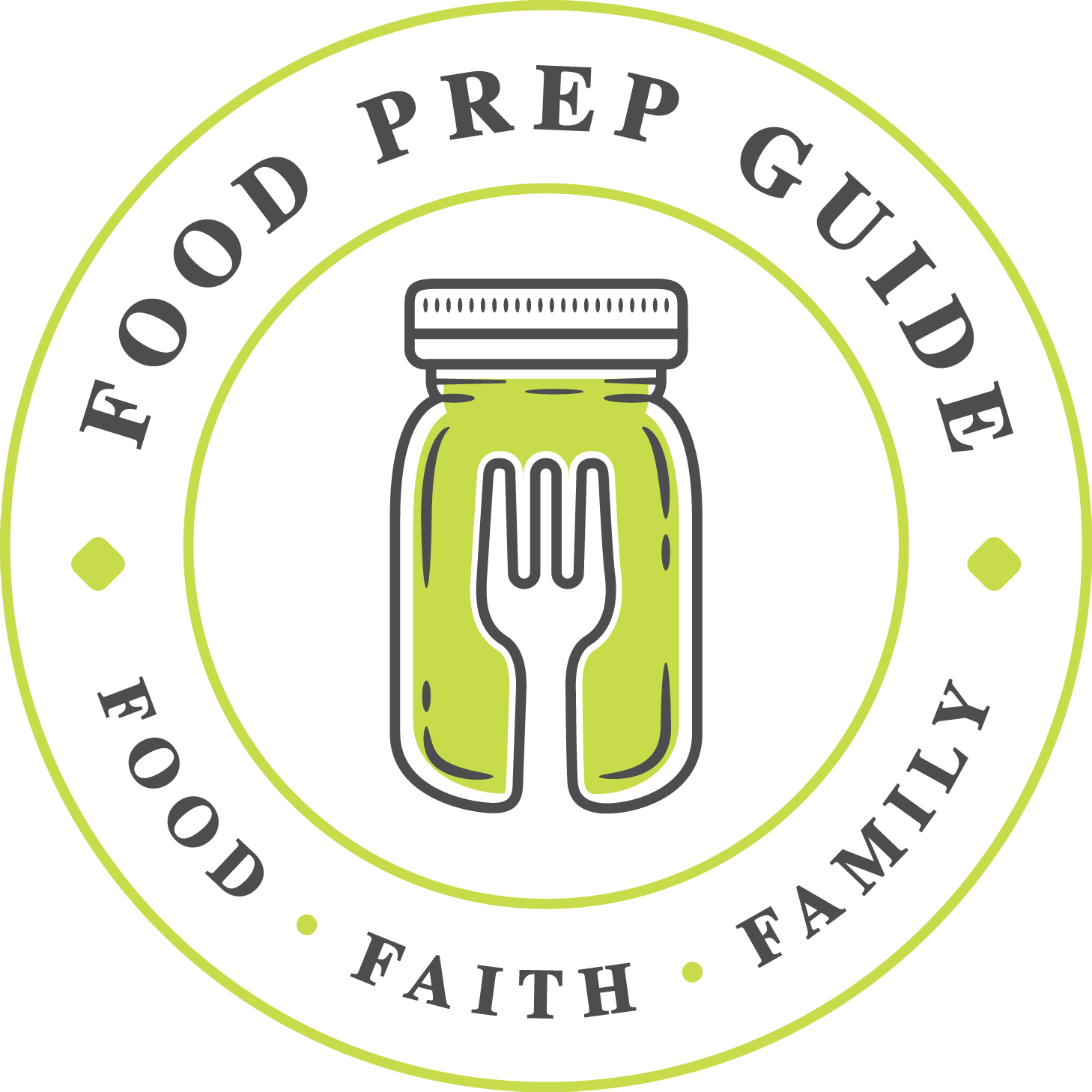
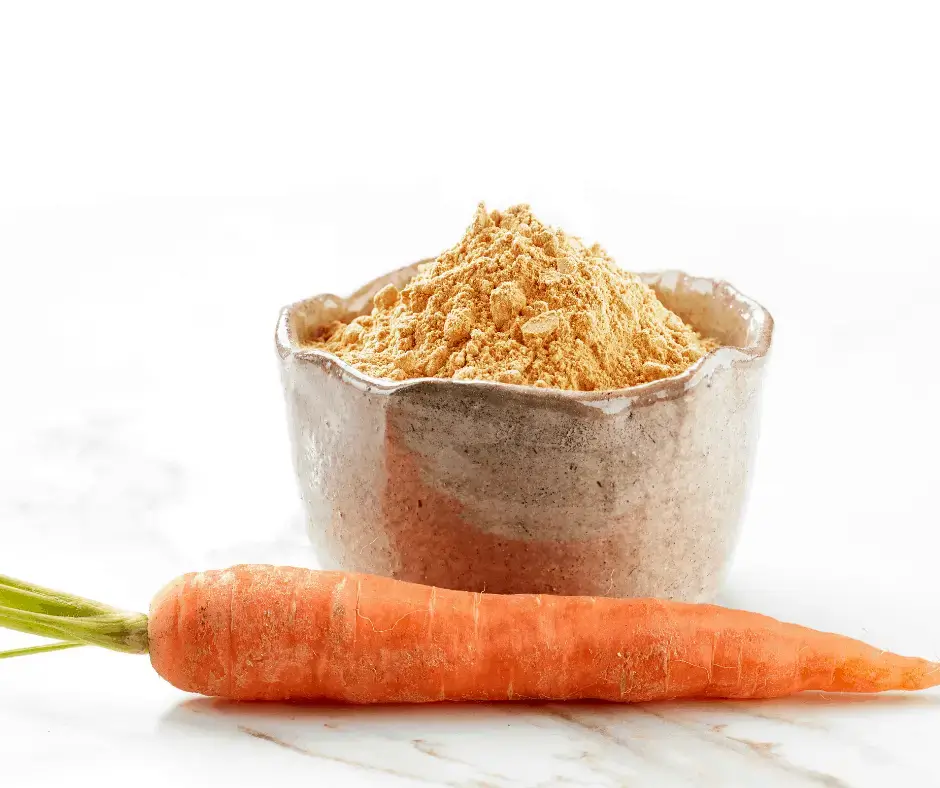

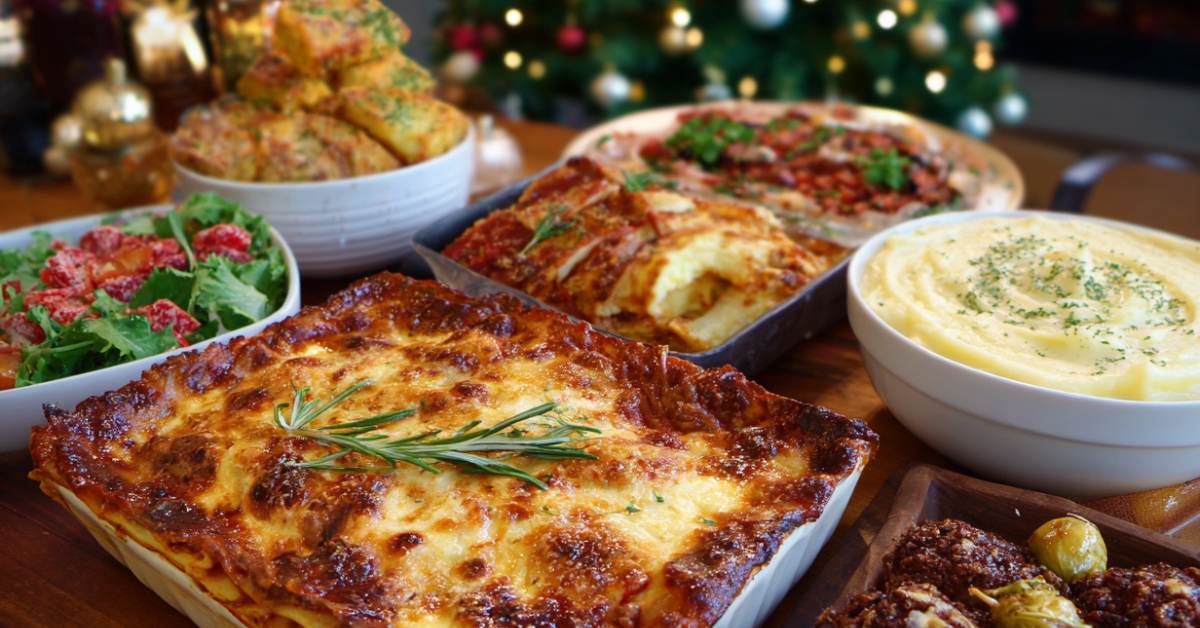


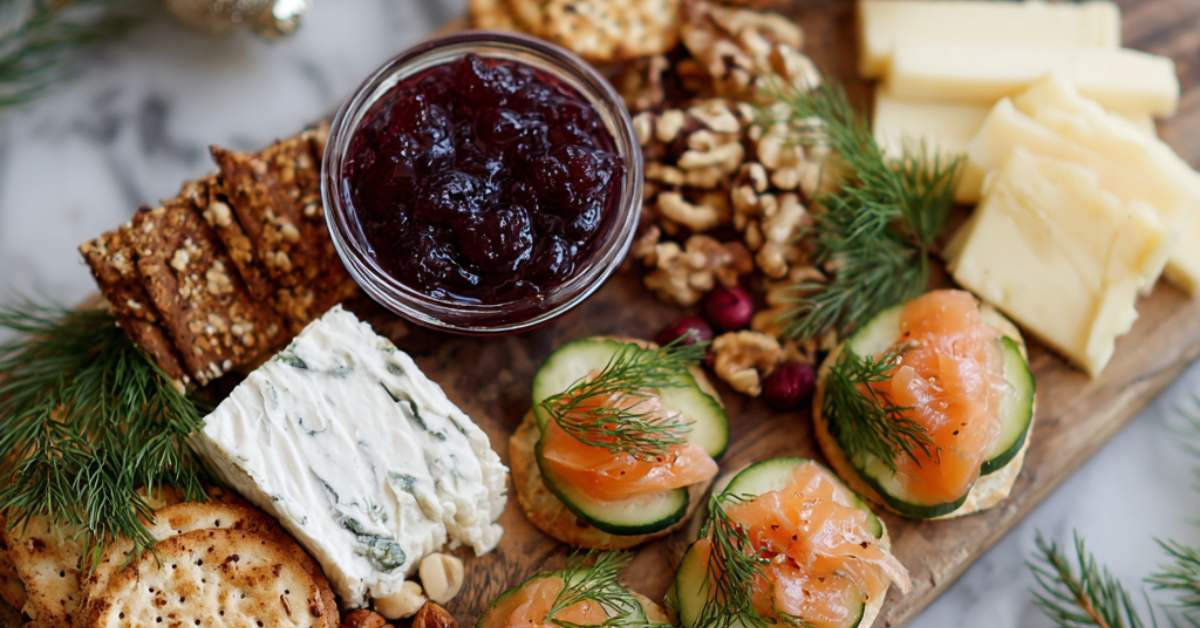


Hi Jordan, Just a quick question about the process. In the to print copy of the recipe, you don’t mention anything about blanching the carrots before drying, but in the article right after that, you say they should be blanched first. Which is correct?
Thank you for bringing this to our attention! For most foods to be dehydrated, blanching is optional. If you want to retain a nice, vibrant orange color & for your carrots to rehydrate slightly faster, you should blanch first. I do like to blanch our carrots before drying. 🙂
I’ll go update the recipe card now. Thanks!
Plus can anyone explain more about blanching
I know this is months later, and I’m not the author, but essentially, blanching stops residual cooking.
So, when you boil carrots (or tomatoes or whatever) and you don’t want them to get mushy from the residual cooking that happens after you remove them from the heat, you drop them into an ice water bath.
While waiting for the food to cook in the pot, I get a large mixing bowl and add enough ice to fill about 1/3 of the way up (maybe more if the bowl is huge) and then fill the rest with cold water. Let the cold water “chill” down for several minutes.
Then, when it’s time, I take a slotted spoon (or tongs) and transfer the food into the ice bath to blanch.
* Don’t pour the hot water into the ice bath. Keep it separate.
* Don’t overcrowd the bowl with the hot food, as it can heat up the water too quickly.
And then, after a couple of minutes, you can remove the food and proceed to the next steps in your recipe. 🙂
I just realized my previous response was mostly focused on the ice bath part, and not the blanching part. Sorry about that!
So, blanching is a quick-cook method that allows the food to retain its crispness/texture along with preserving the color of the food. You’ll see this if you stew your tomatoes and need to remove the skins afterwards (via the ice bath). This is also how many home canners retain the integrity of the vegetable for long-term storage while being in water or some other home canning stable liquid.
If you’re unfamiliar, the University of Georgia’s extension offers safe advice on how to home can.(https://nchfp.uga.edu/how/can)
You mentioned using carrot powder to make baked goods. Do you just add some as part of the flour and add grated carrots to the recipe for carrot muffins?
I add a tablespoon or so to the flour. At that small amount, it doesn’t seem to affect the liquid amount needed in whatever recipe it is, and it adds just a tiny hint of sweetness. 🙂
I’ve actually never made carrot muffins.
Pingback: Using Dehydrated Food: Fruits, Veggies, Herbs, More! • Homestead Lady
Hello , I’m Ugandan and grow a lot of carrots. Am in Food Processing and Baking Industries. Carrots are one of the vegetables that I have on my list of Value Addition. Thank you for sharing more information about a product I have just processed. I will blanch the carrots in the next process and compare with this one I made without blanching. Please share more carrot powder recipes . Thank you.
I like the information are helpful in my research. Article is understood and can be practiced easy. carrot businessman.
May l ask, how long can we store the carrot powder ? Thank you in advance!
Thoroughly dried and properly stored dehydrated fruits and vegetables – like carrot powder – don’t “go bad” in the traditional sense.
They simply degrade (very slowly) in nutrition over time. In that sense, it can last indefinitely, but I’d use within a year for peak nutrition.